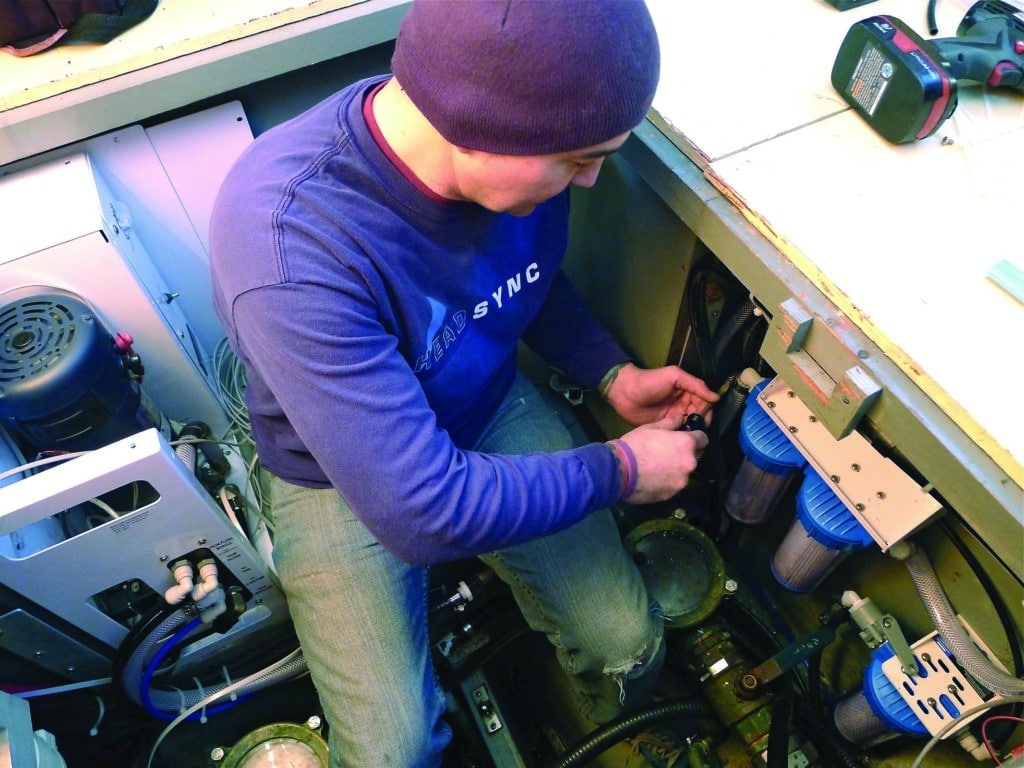
I remember, in the not too distant past, when having a watermaker aboard a cruising boat seemed to be the ultimate luxury. Plenty of sailors considered them too expensive and complicated. Fortunately times have changed. With improved technology and a range of price points on the market, now even average cruising boats of modest means carry a reverse-osmosis system. And really, is there anything that feels better after a day spent sailing and swimming than a hot shower? The freedom and security that come with full water tanks are also a nice bonus, particularly if you’re cruising in an area where fresh water is difficult to come by and pricey when you do.
Choosing a Watermaker
As with any major system, there are many factors to consider when you choose a watermaker. You’ll need to figure out your freshwater needs, the space you have available for the system and how you’re going to power it. Generally speaking, in a reverse-osmosis desalination system the raw water is run through a series of pre-filters, and then a high-pressure pump moves the water through one or more membrane housings. The wastewater, or brine, is released overboard and the product water goes into your water tanks.
Since all of the watermakers that are currently available for cruising sailboats use this process for desalination, the major differences between the systems are how you power the high-pressure pump and the user interface. Powering options include 120/220-volt AC, 12- or 24-volt DC and engine/belt driven. All have their pros and cons.
“The first question I ask a potential customer is ‘Will your boat have a ship’s generator?’” said Rich Boren of Cruise RO Water. “If they plan to have a generator, then the decision to go with a 120-volt high-output watermaker seems natural. While running the generator for battery charging and other loads two to three times per week, they can keep their water tanks full without having to make generator runs just to make water.”
A 12-volt system, such as the Spectra Catalina 300 Mk II or the Horizon Reverse Osmosis Seafari Quest, makes a lot of sense for smaller cruising boats since they don’t need a generator to run and have fairly miserly power consumption. On a breezy, sunny day, a solar panel and/or a wind generator will likely keep up with the demand. “The only difference between 12-volt DC low-output and 120-volt AC high-output watermakers is how the high-pressure pump brings seawater up to the 800 psi needed to drive fresh water through the reverse-osmosis membrane,” Boren said. “The membrane and support equipment, like pre-filtering and plumbing, are the same.”
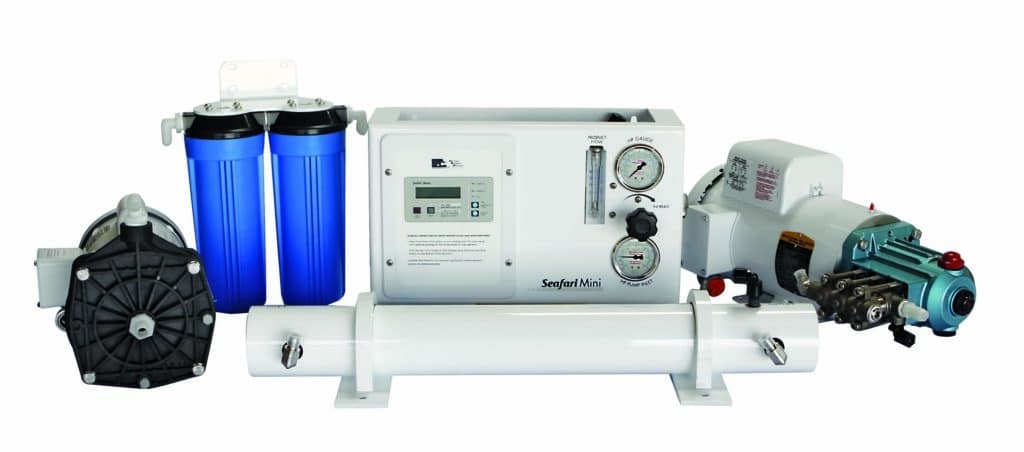
These systems typically produce anywhere from about 6 to 16 gallons per hour, and some units can do so for about a 1-amp-per-gallon power draw.
“Many smaller sailboats, under 45 feet or so, often utilize solar panels,” said Berkeley Andrews of Parker Hannifin, which produces Sea Recovery, Horizon Reverse Osmosis and Village Marine watermaker systems. “Their entire electrical backbone consists of 12-volt or 24-volt. So they must have a watermaker that can operate on low voltage. These customers have limited amp hours on their batteries, so all of their equipment must be suited to handling this.”
In choosing a watermaker, Bill Edinger, owner of Spectra Watermakers, said to be realistic about water needs. “When helping customers decide which system is right for them, first we like to determine their approximate water usage with questions like ‘How many people are aboard normally? Are you going to be living on the boat full time? Do you have a washing machine? Any children? Are you going to be cruising full time or leaving the boat for extended periods?”
A common error people make is choosing a watermaker that is too small for their needs. “The most common mistake I see cruisers making in their watermaker purchase decision is underestimating how much water it will take them to cruise comfortably,” Boren says. “I’m not talking about the minimal amount of water it takes for the crew to stay alive, because there is a big difference between staying alive and comfort. Selecting a watermaker that will only meet their minimal drinking-water needs but not keep up with the comfort needs of the crew can lead to crew tensions and feeling like camping rather than cruising.”
Remember that “watermakers are rated in gallons of production in a 24-hour period,” Edinger said. “So a 300-gallon-per-day watermaker system sounds like a lot of water. The important thing is that it produces about 12 gallons per hour. Normally a system like this will be run three to four hours per day if power is not a critical issue, in this case producing 36 to 48 gallons of water. It’s better for a system to run for a few hours every few days than an hour every day.”
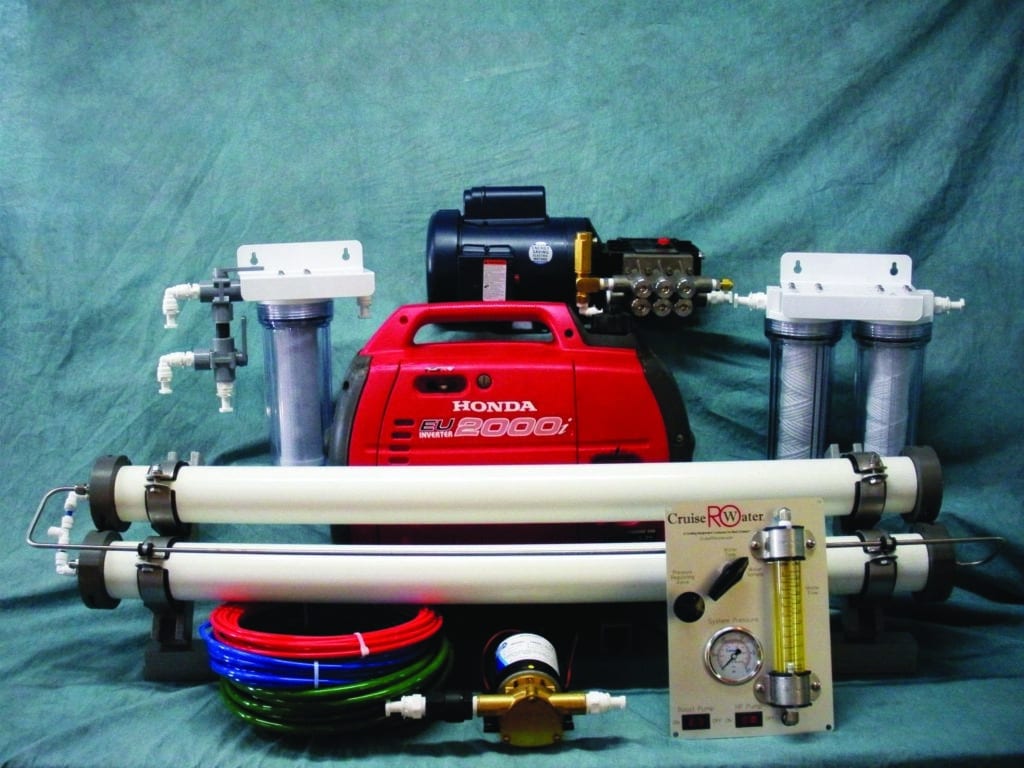
Watermakers for Small Boats
If space is at a premium, consider purchasing a modular system instead of an enclosed one. In a modular system, the components, such as the membranes and filters, can be mounted separately. Another power source for the high-pressure pump is the boat’s diesel engine. In these engine-driven setups, the pump and an additional pulley are mounted on a custom bracket next to the engine. The watermaker can then be run while motoring or using the engine to charge the batteries.
While engine-driven watermakers can produce a large amount of water, 20 or more gallons an hour on average, the downside is that the installation can be more complex than for other systems. “Unlike the 12-volt DC or 120-volt AC watermakers, where you simply bolt the high-pressure pump down and then run the wires and plumbing hoses, the hardest installation aspect of an engine-driven watermaker is finding space. Some boats simply have no room in the engine compartment to mount the 5-pound pump with a 7-inch pulley on the engine while still leaving access to other engine parts that need to remain serviceable,” Boren says.
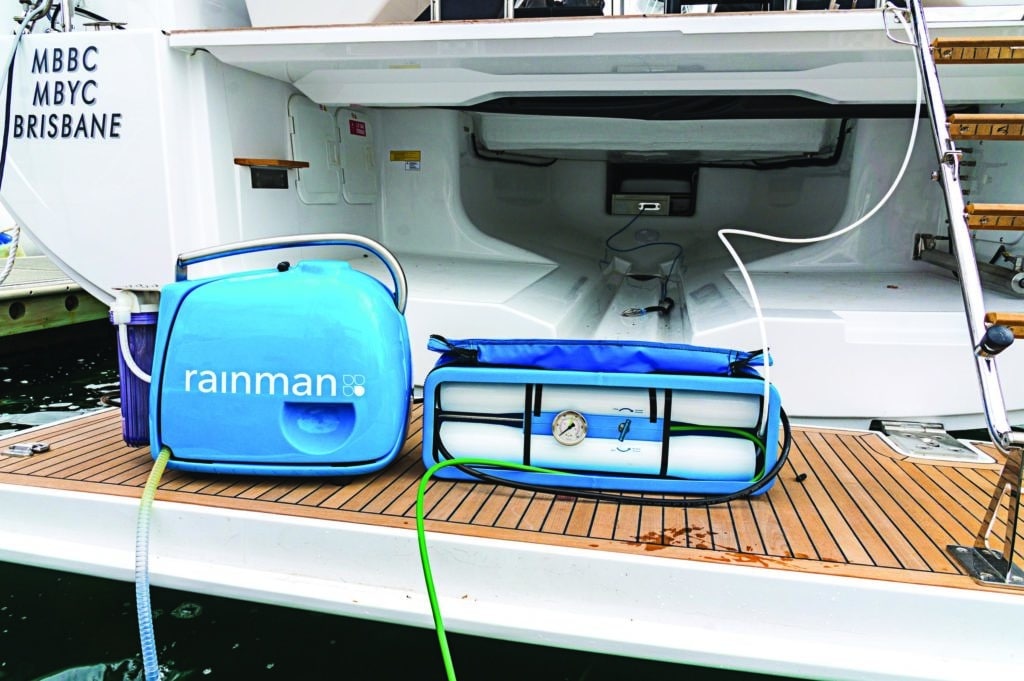
A relative newcomer to the marine market, the portable watermaker is a good solution for cruisers who want the convenience of a watermaker but don’t want to permanently install one. The Rainman is one such system that is available as a self-contained unit driven by a gasoline-powered Honda motor, or as a 115-volt AC-powered unit. “The bulk of our gasoline-powered system customers are sailing yachts between 30 and 50 feet,” said Ron Schroeder of Rainman Desalination. “Our customers seem to prefer to have a simple and somewhat manual system over one that relies on control panels, software and solenoid valves. We are also attractive to those customers who have had bad experiences with the installation process of an installed system.”
The Spectra Passport is another portable system. Edinger said it has already proved popular with offshore race crews and cruisers who need a watermaker for only a limited time.
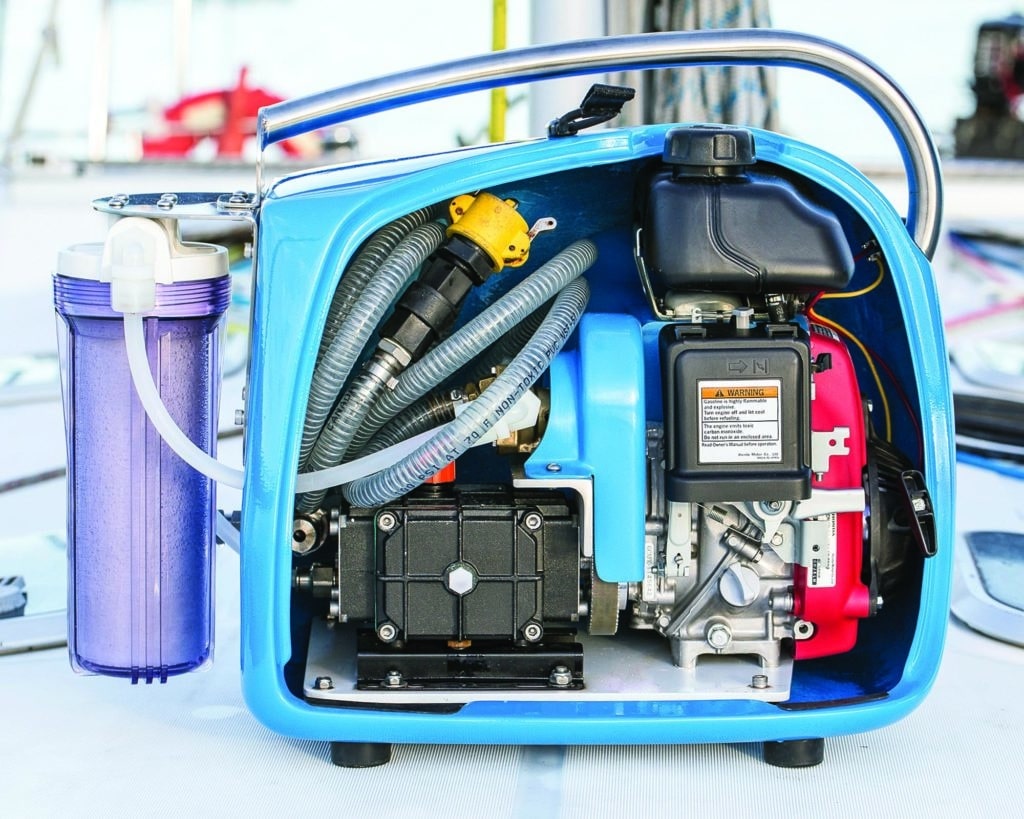
Maintenance for Watermakers
Watermakers have long had a reputation for being difficult to maintain, but the equipment has improved over the years and overall, routine maintenance isn’t more challenging than with other onboard systems. “The best rule of thumb is to operate the watermaker in water that looks good,” Andrews said. “There are a few factors in the feed-water condition that come into play. Operating a watermaker in dirty harbors will most certainly result in repeated pre-filter changes and a clogged sea strainer. If you have extra filters on board, you can get by, but it’s not recommended. The environment in the open ocean and remote anchorages is much better. Also consider how shallow the water is where you’re anchored. Sometimes there can be a lot of tidal movement, which can kick up fine particulate and sediment. This too can also contribute to more frequent filter changes and even damage other components. A nice option is an automatic freshwater flush, which will rinse the watermaker’s membrane element after use. It helps keep the membrane vessel housing free of any biological growth that could foul the membrane and reduce your ability to produce fresh water.”
Whatever system you choose, with proper use and maintenance you can expect years of service from your watermaker. And plenty of hot showers.
Jen Brett is a CW associate editor. This article first appeared in the February 2015 issue of Cruising World.
Resources
Aqua Marine: www.aquamarineinc.net
Blue Water Desalination: www.bluewaterdesalination.com
Cruise RO: www.cruiserowaterandpower.com
Dometic Marine Sea Xchange: www.dometic.com
ECHOTec: www.echotecwatermakers.com
FCI Watermakers: www.filtrationconcepts.com
Horizon Reverse Osmosis (HRO): www.hrosystems.com
Katadyn: www.katadyn.com
Rainman: www.rainmandesal.com
Sea Recovery: www.searecovery.com
Schenker Watermakers: www.schenkerwatermakers.com
SK Watermakers: www.skwatermakers.net
Spectra Watermakers: www.spectrawatermakers.com
Village Marine Tec: www.villagemarine.com
Watermakers Inc.: www.watermakers.com








